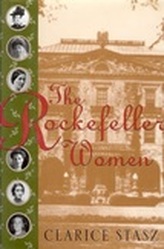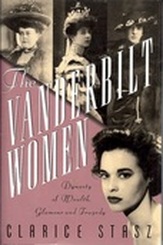The Rockefellers and the Vanderbilts

The Rockefeller Women: Dynasty of Piety, Privacy, and Service.
St. Martin's Press, 1995, paperback, i Universe, 1999. E-book.
This elite family set very different standards from the Vanderbilts, for it was born in liberal Protestant social consciousness. Here women more shaped male achievement, and were more restricted in their self-expression. John D.'s daughter Edith McCormick was a major Chicago philanthropist and studied with Carl Jung for many years, yet was belittled by her father and brother. The wives managed significant contributions, such as Abby Aldrich Rockefeller, an originator of the Museum of Modern Art, and Blanchette Rockefeller, who established standards for socially prominent women to contribute to boards once denied to females. Mary Rockefeller was a lifelong environmentalist, while Happy Rockefeller helped break barriers concerning breast cancer.
REVIEWS
"In another solid exercise in restorative history, Stasz, professor of history at Sonoma State University in California, tries to do for the Rockefeller women what she did in The Vanderbilt Women. Tracing the billionaires from John D. and Laura Rockefeller (married in 1864) to Governor Nelson and Happy Rockefeller (married in 1963), she chronicles the women's philanthropic activities (John Jr.'s wife, Abby, was a founder of the Museum of Modern Art) and eccentricities (John D.'s daughter, Edith, became a Jungian lay analyst and financially supported James Joyce, advising him in vain to go into therapy with Carl Jung). It is all conscientiously recorded, and Stasz draws a convincing picture of a more genuine religious commitment than the rich are usually given credit for." Publishers Weekly
"By plumbing the depths of the family's archives, Stasz was able to draw on countless letters and diaries for her expansive, scholarly account highlighting four generations of Rockefeller women. At the heart of this highly readable text are the societal and religious forces that shaped the character of these women and contributed to their influential presence both within the family and in the public arena. For readers who found Stasz's previous book, The Vanderbilt Women, of interest, there are all sorts of sobering insights into another great American dynasty to be gleaned here. A highly readable study offering an analytical perspective, rich in historical detail. " Booklist
St. Martin's Press, 1995, paperback, i Universe, 1999. E-book.
This elite family set very different standards from the Vanderbilts, for it was born in liberal Protestant social consciousness. Here women more shaped male achievement, and were more restricted in their self-expression. John D.'s daughter Edith McCormick was a major Chicago philanthropist and studied with Carl Jung for many years, yet was belittled by her father and brother. The wives managed significant contributions, such as Abby Aldrich Rockefeller, an originator of the Museum of Modern Art, and Blanchette Rockefeller, who established standards for socially prominent women to contribute to boards once denied to females. Mary Rockefeller was a lifelong environmentalist, while Happy Rockefeller helped break barriers concerning breast cancer.
REVIEWS
"In another solid exercise in restorative history, Stasz, professor of history at Sonoma State University in California, tries to do for the Rockefeller women what she did in The Vanderbilt Women. Tracing the billionaires from John D. and Laura Rockefeller (married in 1864) to Governor Nelson and Happy Rockefeller (married in 1963), she chronicles the women's philanthropic activities (John Jr.'s wife, Abby, was a founder of the Museum of Modern Art) and eccentricities (John D.'s daughter, Edith, became a Jungian lay analyst and financially supported James Joyce, advising him in vain to go into therapy with Carl Jung). It is all conscientiously recorded, and Stasz draws a convincing picture of a more genuine religious commitment than the rich are usually given credit for." Publishers Weekly
"By plumbing the depths of the family's archives, Stasz was able to draw on countless letters and diaries for her expansive, scholarly account highlighting four generations of Rockefeller women. At the heart of this highly readable text are the societal and religious forces that shaped the character of these women and contributed to their influential presence both within the family and in the public arena. For readers who found Stasz's previous book, The Vanderbilt Women, of interest, there are all sorts of sobering insights into another great American dynasty to be gleaned here. A highly readable study offering an analytical perspective, rich in historical detail. " Booklist

The Vanderbilt Women: Dynasty of Wealth, Glamour, and Power.
St. Martin's Press, 1991; paperback, i Universe, 1999. E-book.
Book of the Month Club Alternate Selection.
This began as a biography of Alva Vanderbilt Belmont, the brilliant suffragist theorist of the National Women's Party, but soon expanded to cover four generations of women in the family as a way of examining changing gender roles and power. Alva's daughter Consuelo became the Duchess of Marlborough, and also supported women's rights overseas. Others given lengthy attention were the sculptress and creator of the Whitney Museum, Gertrude Vanderbilt Whitney, and Gloria Vanderbilt, who became a prominent businesswoman. These women broke with major unspoken rules of their elite caste in seeking lives of self-assertion and independence.
"Through the Vanderbilts, Stasz analyzes the characteristic patterns of women's lives: strong friendships, the nest versus the quest, the mother-daughter know, the fierce energy that may produce depression or rage--or art and revolution. This is the best kind of feminist biography." Women's Review of Books
"Many biographers of the rich have not been sympathetic, and they have been particularly ungenerous to the females in such families, dismissing them as social butterflies, suggests Stasz . That the Vanderbilt women by and large must be taken seriously is convincingly proved by this lively scholarly account of the social/financial dynasty from 1650 to the present, with the emphasis on the last century. Of special interest are discussions of Gertrude Vanderbilt Whitney (1875-1942), a sculptor, who recovered from a singularly unhappy marriage by dedicating herself to a series of male and female lovers and by establishing Manhattan's Whitney Museum of American Art; Alva Smith Vanderbilt (1853-1933), who put aside her frenetic efforts to become New York City's social arbiter to play a significant role in the women's suffrage movement; and today's Gloria, "the Poor Little Rich Girl," subjected to a vicious custody battle as a child, who found contentment in her fourth marriage and a successful business career." Publishers Weekly